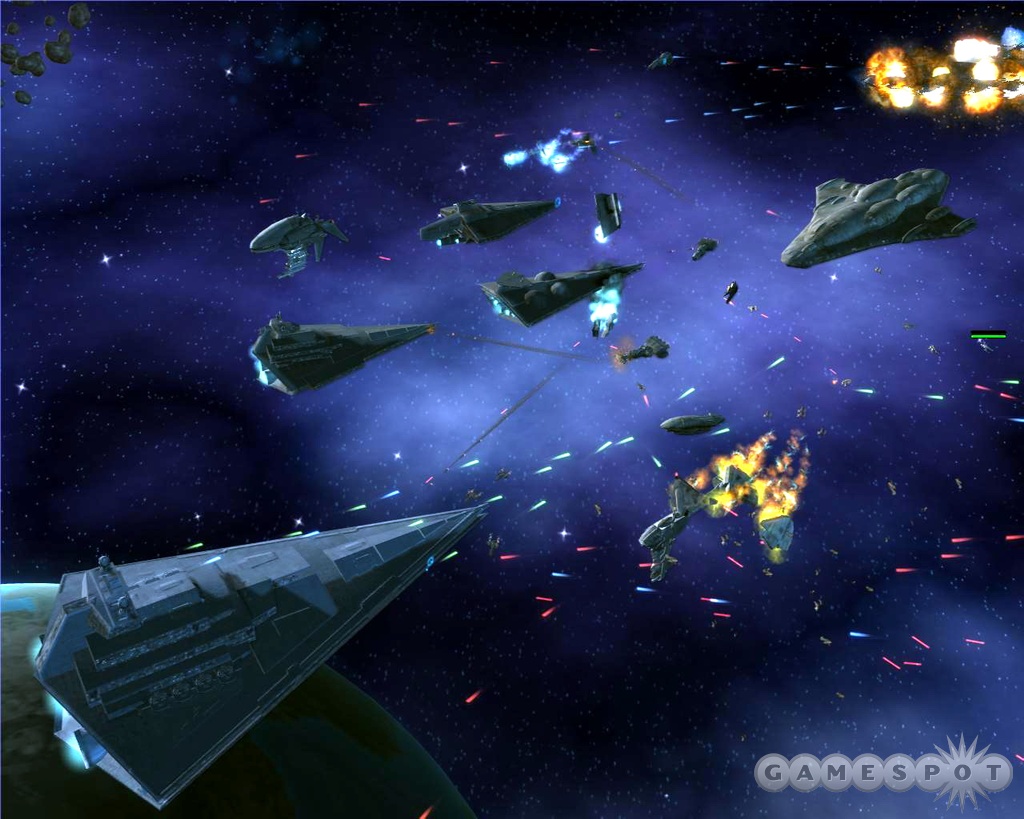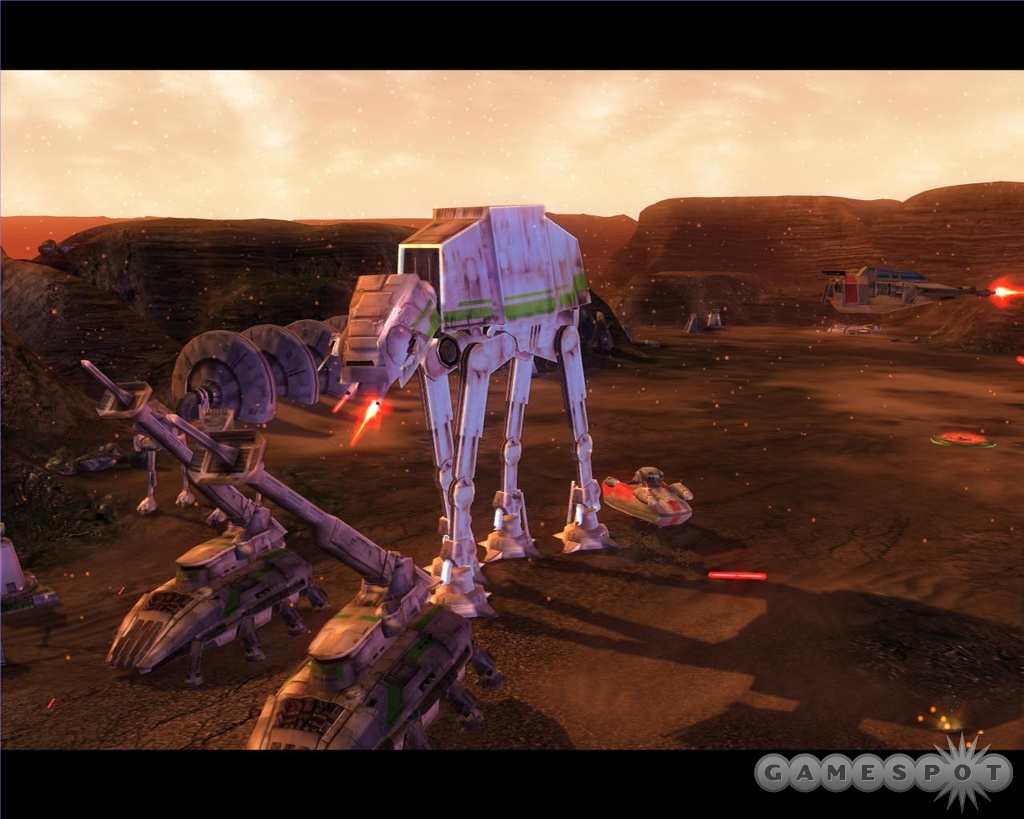Star Wars: Empire at War Designer Diary #4 - Audio in a Galaxy Far, Far Away
Petroglyph audio director Frank Klepacki got the thrill of a lifetime when he designed the audio for Empire at War. But, as he also explains, it was a lot of work.
You may think it would be easy to create audio for a Star Wars game. All you'd have to do is just import all the sounds and music from the famous movies. But, like many things in life, it's just not that easy. So when Petroglyph got the job to create Star Wars: Empire at War for LucasArts, audio director Frank Klepacki found that his plate was full. He had to create sounds, music, and dialogue for the game that would be unique to Empire at War, but that would also fit into the well-known Star Wars universe. We'll let him explain in this chapter of our designer diaries.

A Fully Operational Surround-Sound System
By Frank KlepackiAudio Director, Petroglyph
When Petroglyph was hired to create Star Wars: Empire at War for LucasArts, I couldn't have been happier. Star Wars is my favorite saga of all time, and to be involved in it is certainly the peak of my career. My approach as audio director was to stay as true as possible to the feel of the Star Wars films in all aspects of audio. Since this game takes place just before Episode IV, the focus was on the original trilogy. It was my task on the project to cover sound design, music, and implementation.
Surround sound was important to me in this game, as many past real-time strategy games didn't take full advantage of it. Empire at War is in full EAX surround for every bit of in-game action. You will be completely immersed as weather increases and decreases in intensity in real-time, big ships and vehicles have seamless engine idle and movement sounds, fighters do flybys, and ambient sounds of terrain play in 3D all around you in each specific environment. Not to mention, when you activate the cinematic mode, you literally are put in the center of the action to watch your battles unfold!
To spice things up, I not only used signature sounds from the films, but also mixed in new elements to add more variety without compromising the Star Wars sound. It isn't just importing the movie sounds; there's so much to the game that you'll find yourself running out of sounds quickly (especially explosions). I created a good number of sounds myself, as well as various creature sounds like new wookiees, jawas, and rancor sounds, Force and special ability effects, all sounds in the interface, and all of the structure sounds. I have always paid close attention to Ben Burtt's sound design, and even more so during this process in creating new sounds that emulate his style. One thing for certain is that Ben really loves flangers!
With a lot of attention to even the subtle details, you'll hear everything from blaster ricochets, specific hard-point destruction, variable lasers, specific sounds for the different animations of each and every unit (down to the smallest movements of C-3PO and R2-D2 moving their joints), and Darth Vader breathing randomly about the battlefield...and when he uses the Force, you will feel the rumbling crush you! Indigenous creatures round out the inhabitants of the various planets, while asteroids pound on large ships in space!
Then there's dialogue. From day one, I had envisioned that what would really put this game over the top would be to cleverly devise a way to make the units smarter by having them react with dialogue to specific situations, such as sighting the enemy, space obstacles, announcing the arrivals of friendly and enemy heroes, space fighters cross-talking to each other in dogfights, and heroes vocalizing urgency when they are in trouble. I got the president of Petroglyph, Mike Legg himself, to program our whole audio engine and make it possible. We also had a system put into place that allowed groups of selected units to interact with each other by voicing assistance lines to each other, with heroes as well as highest-ranked units leading them when grouped together. You really get a sense that the human element is present!
Will Beckman at LucasArts (the voice lead for Empire at War) cast the parts and worked with me in refining the direction and role that voice would play in this game. Will came up with the idea of adding twice as many unit responses than any other real-time strategy game, to make the units less repetitive and get more life out of them through constant use. We took it upon ourselves to write a lot of the unit-response dialogue based upon the Star Wars movie scripts, utilizing some classic dialogue associated with certain characters, and the type of battle dialogue you'd expect from a Star Wars film. It was clear that Will and I shared the same vision for how it would all be implemented, and that made the process that much smoother through the course of development.
I really loved working with the whole voice department at LucasArts, because not only do they understand Star Wars, they understood the game we were making and really rallied behind it. I knew Will could take the reigns and get some great performances out of the actors, as well as provide great input along the way. A couple of great bonuses to the voices in the game were getting Temura Morisson to voice Boba Fett, and Jamie Glover as Veers! Our jaws dropped when Jamie told us his father was in fact the actual General Veers in Empire Strikes Back. Will also miraculously found a fantastic Han Solo in the voice of John Armstrong at the tail end of the voice-recording process. I was amazed how well he really captured all the nuances of Harrison Ford to the tee, adding all the more character to Han's backstory.

It's no secret that Star Wars fans love John Williams' music, as it's one of the most moving parts of the films. Being that the game focuses on the original trilogy, I also focused on the original scores. Very few of the prequel pieces are used in this game, and of course, I had to compose some new pieces to have something new and exclusive to this title. I put on my best Williams hat and composed 20-percent, brand-new music for the game to enhance land and space environments that weren't really present in the original trilogy, and to help round out the experience.
With great attention to detail, I emulated Williams' style, I emulated the concert hall reverb, the EQ of the instruments, and the panning of the orchestras used in the soundtracks. I even created a couple of new signature melodies associated with Empire at War that reoccur within the new themes I created. Ambient and battle pieces are cleverly assigned to different terrain types, so whenever there's a different environment there's different music for it. Special case themes are also assigned for battling in front of the Death Star and specific events throughout the game. As a fan, it was important to me to keep the movie moments that were familiar from the original trilogy, while taking the opportunity to add new original themes to areas that we didn't see too much of in those films. Listen for some of the newer themes in the forest, volcanic, swamp, and urban areas, as well as in space!
Combining all of this took a lot of hard work in terms of creativity and programming, but it really makes this an innovative sound experience that we're very excited for the players and fans to experience!
Got a news tip or want to contact us directly? Email news@gamespot.com
Join the conversation